Matrix exponential - Wikipedia, the free encyclopedia
http://en.wikipedia.org/wiki/Matrix_exponential
Matrix exponential
From Wikipedia, the free encyclopedia
In mathematics, the matrix exponential is a function on square matrices analogous to the ordinary
exponential function. Abstractly, the matrix exponential gives the connection between a matrix Lie algebra and
the corresponding Lie group.
Let X be a n×n real or complex matrix. The exponential of X, denoted by eX or exp(X), is the n×n matrix given
by the power series:
The above series always converges, so the exponential of X is well-defined. Note that if X is a 1×1 matrix the
matrix exponential of X corresponds with the ordinary exponential of X thought of as a number.
Contents
1 Properties
1.1 Linear differential equations
1.2 The exponential of sums
1.3 The exponential map
2 Computing the matrix exponential
2.1 Diagonalizable case
2.2 Nilpotent case
2.3 General case
3 Calculations
4 Applications
4.1 Linear differential equations
4.1.1 Example (homogeneous)
4.1.2 Inhomogeneous case - variation of parameters
4.1.3 Example (inhomogeneous)
5 See also
6 References
Properties
Let X and Y be n×n complex matrices and let a and b be arbitrary complex numbers. We denote the n×n
identity matrix by I and the zero matrix by 0. The matrix exponential satisfies the following properties:
e0 = I.
eaXebX = e(a + b)X.
eXe - X = I.
If Y is invertible then
det(eX) = etr(X).
exp(XT) = (eX)T, where XT denotes the transpose of X. It follows that if X is symmetric then eX is also
.
1 of 8
14/03/2006 19:31
�
Matrix exponential - Wikipedia, the free encyclopedia
http://en.wikipedia.org/wiki/Matrix_exponential
symmetric, and that if X is skew-symmetric then eX is orthogonal.
exp(X*) = (eX)*, where X* denotes the conjugate transpose of X. It follows that if X is Hermitian then eX
is also Hermitian, and that if X is skew-Hermitian then eX is unitary.
Linear differential equations
One of the reasons for the importance of the matrix exponential is that it can be used to solve systems of linear
ordinary differential equations. Indeed, it follows from equation (1) below that the solution of
where A is a matrix, is given by
The matrix exponential can also be used to solve the inhomogeneous equation
See the section on applications below for examples.
There is no closed-form solution for differential equations of the form
where A is not constant, but the Magnus series gives the solution as an infinite sum.
The exponential of sums
We know that the exponential function satisfies ex + y = exey for any numbers x and y. The same goes for
commuting matrices: If the matrices X and Y commute (meaning that XY = YX), then
However, if they do not commute, then the above equality does not necessarily hold. In that case, we can use
the Baker-Campbell-Hausdorff formula to compute eX + Y.
The exponential map
Note that the exponential of a matrix is always a non-singular matrix. The inverse of eX is given by e- X. This is
analogous to the fact that the exponential of a complex number is always nonzero. The matrix exponential then
gives us a map
from the space of all n×n matrices to the general linear group, i.e. the group of all non-singular matrices. In
fact, this map is surjective which means that every non-singular matrix can be written as the exponential of
some other matrix (for this, it is essential to consider the field C of complex numbers and not R). The matrix
logarithm gives an inverse to this map.
For any two matrices X and Y, we have
2 of 8
14/03/2006 19:31
�
Matrix exponential - Wikipedia, the free encyclopedia
http://en.wikipedia.org/wiki/Matrix_exponential
where || · || denotes an arbitrary matrix norm. It follows that the exponential map is continuous and Lipschitz
continuous on compact subsets of Mn(C).
The map
defines a smooth curve in the general linear group which passes through the identity element at t = 0. In fact,
this gives a one-parameter subgroup of the general linear group since
The derivative of this curve (or tangent vector) at a point t is given by
The derivative at t = 0 is just the matrix X, which is to say that X generates this one-parameter subgroup.
Computing the matrix exponential
Diagonalizable case
If a matrix is diagonal:
then its exponential can be obtained by just exponentiating every entry on the main diagonal:
This also allows one to exponentiate diagonalizable matrices. If A = UDU- 1 and D is diagonal, then eA =
UeDU- 1.
Nilpotent case
A matrix N is nilpotent if Nq = 0 for some integer q. In this case, the matrix exponential eN can be computed
directly from the series expansion, as the series terminates after a finite number of terms:
General case
3 of 8
14/03/2006 19:31
�
Matrix exponential - Wikipedia, the free encyclopedia
http://en.wikipedia.org/wiki/Matrix_exponential
An arbitrary matrix X (over an algebraically closed field) can be expressed uniquely as sum
where
A is diagonalizable
N is nilpotent
A commutes with N (i.e. AN = NA)
This means we can compute the exponential of X by reducing to the previous two cases:
Note that we need the commutativity of A and N for the last step to work.
Another (closely related) method is to work with the Jordan form of X. Suppose J is the Jordan form of X, with
P the transition matrix. Then
Also, since
Therefore, we need only know how to compute the matrix exponential of a Jordan block. But each Jordan
block is of the form
where N is a special nilpotent matrix. The matrix exponential of this block is given by
Calculations
Consider the matrix
which has Jordan form
and transition matrix
4 of 8
14/03/2006 19:31
�
Matrix exponential - Wikipedia, the free encyclopedia
http://en.wikipedia.org/wiki/Matrix_exponential
Now,
and
So,
The exponential calculation for a 1×1 matrix is clearly trivial, with eJ1(4)=e4 so,
Clearly, to calculate the Jordan form and to evaluate the exponential this way is very tedious. Often, it will
often suffice to calculate the action of the exponential matrix upon some vector in applications, and there are
other methods available to achieve this.
Applications
Linear differential equations
The matrix exponential has applications to systems of linear differential equations. Recall that a differential
equation of the form
y' = Cy
has solution eCx. If we consider the vector
we can express a system of coupled linear differential equations as
If we make an ansatz and use an integrating factor of e- Ax and multiply throughout, we obtain
5 of 8
14/03/2006 19:31
�
Matrix exponential - Wikipedia, the free encyclopedia
http://en.wikipedia.org/wiki/Matrix_exponential
If we can calculate eAx, then we can obtain the solution to the system.
Example (homogeneous)
Say we have the system
We have the associated matrix
In the example above, we have calculated the matrix exponential
so the general solution of the system is
that is,
Inhomogeneous case - variation of parameters
For the inhomogeneous case, we can use a method akin to variation of parameters. We seek a particular
solution of the form yp(t)=exp(tA)z(t) :
For yp to be a solution:
6 of 8
14/03/2006 19:31
�
Matrix exponential - Wikipedia, the free encyclopedia
http://en.wikipedia.org/wiki/Matrix_exponential
So,
where c is determined by the initial conditions of the problem.
Example (inhomogeneous)
Say we have the system
So we then have
and
From before, we have the general solution to the homogeneous equation, Since the sum of the homogeneous
and particular solutions give the general solution to the inhomogeneous problem, now we only need to find the
particular solution (via variation of parameters).
We have, above:
7 of 8
14/03/2006 19:31
�
Matrix exponential - Wikipedia, the free encyclopedia
http://en.wikipedia.org/wiki/Matrix_exponential
which can be further simplified to get the requisite particular solution determined through variation of
parameters.
See also
exponential function
exponential map
vector flow
References
Roger A. Horn and Charles R. Johnson. Topics in Matrix Analysis. Cambridge University Press, 1991.
ISBN 0-521-46713-6.
Retrieved from "http://en.wikipedia.org/wiki/Matrix_exponential"
Categories: Matrix theory | Lie groups
This page was last modified 21:31, 1 February 2006.
All text is available under the terms of the GNU Free Documentation License (see Copyrights for details).
Wikipedia® is a registered trademark of the Wikimedia Foundation, Inc.
Privacy policy
About Wikipedia
Disclaimers
8 of 8
14/03/2006 19:31
�
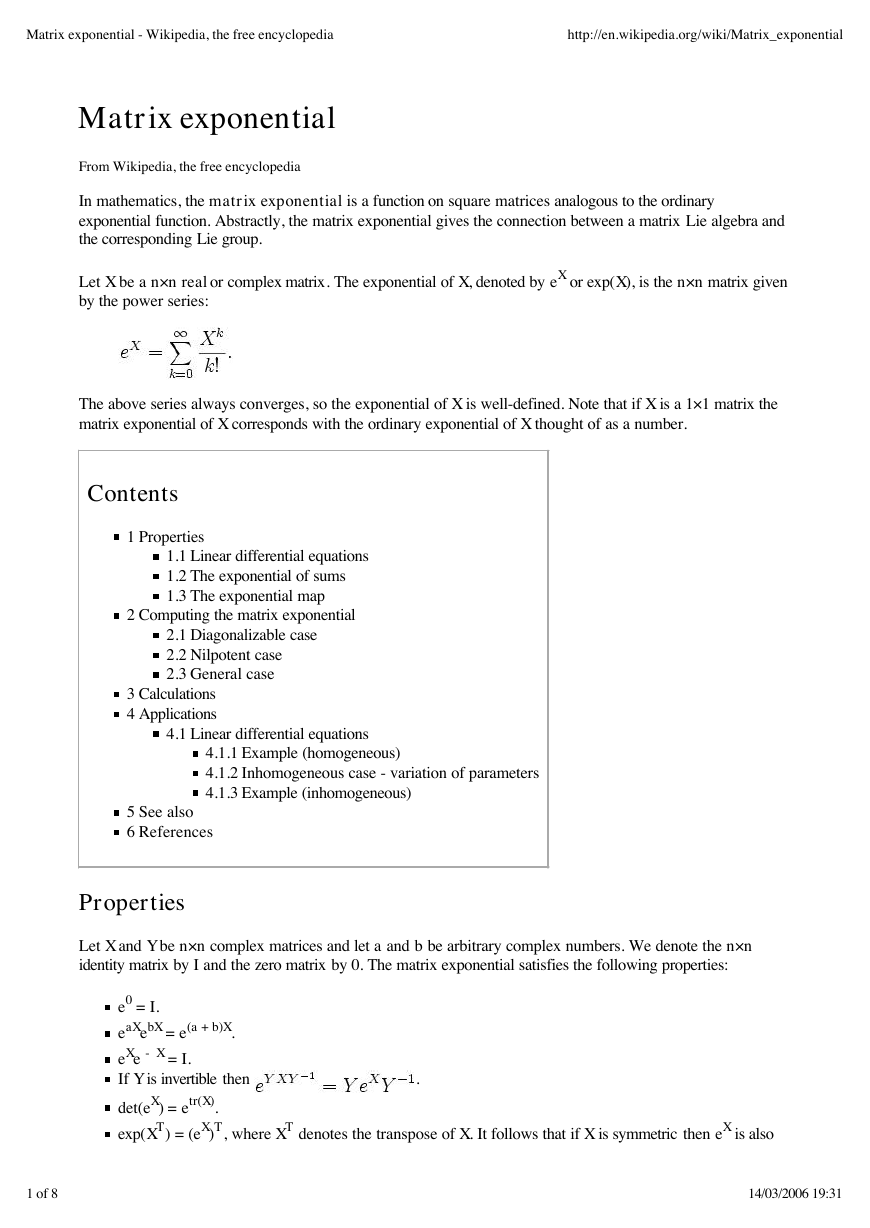
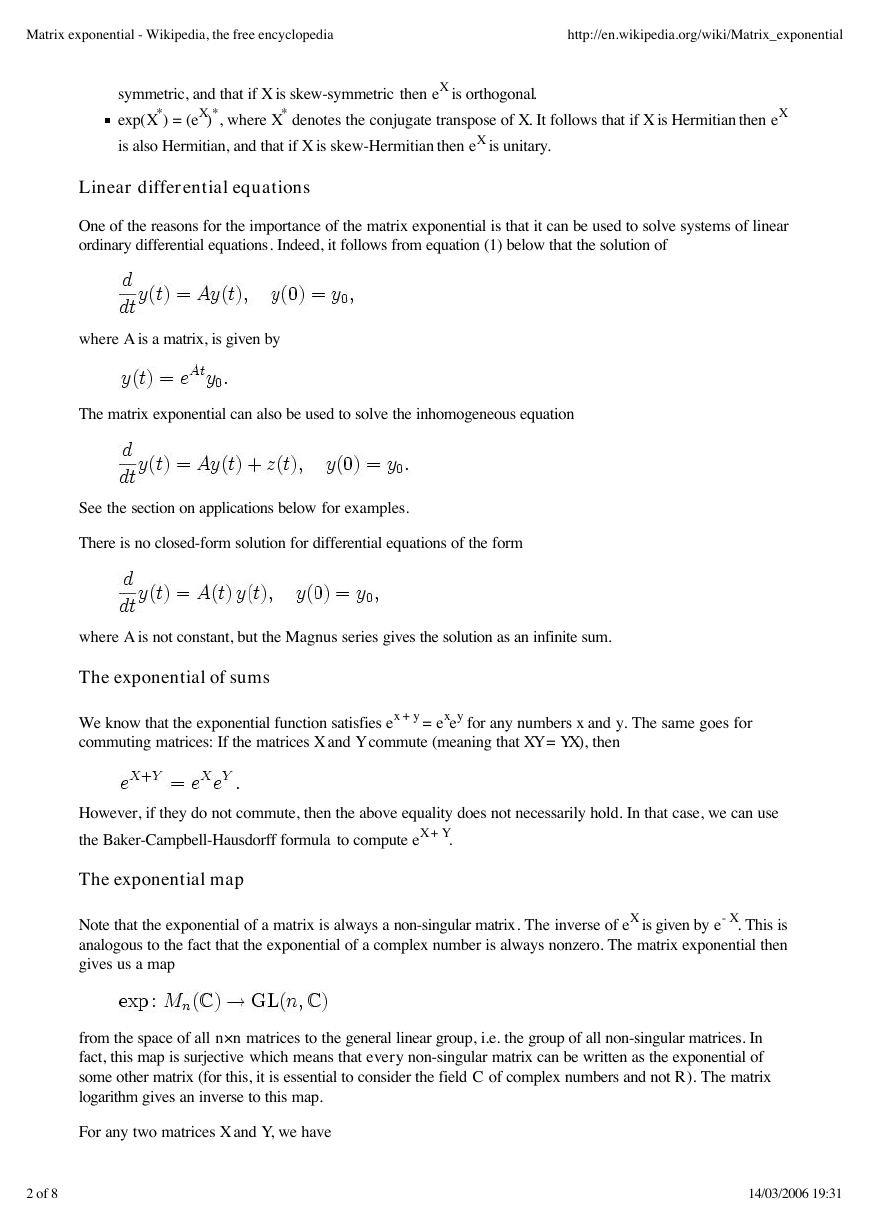
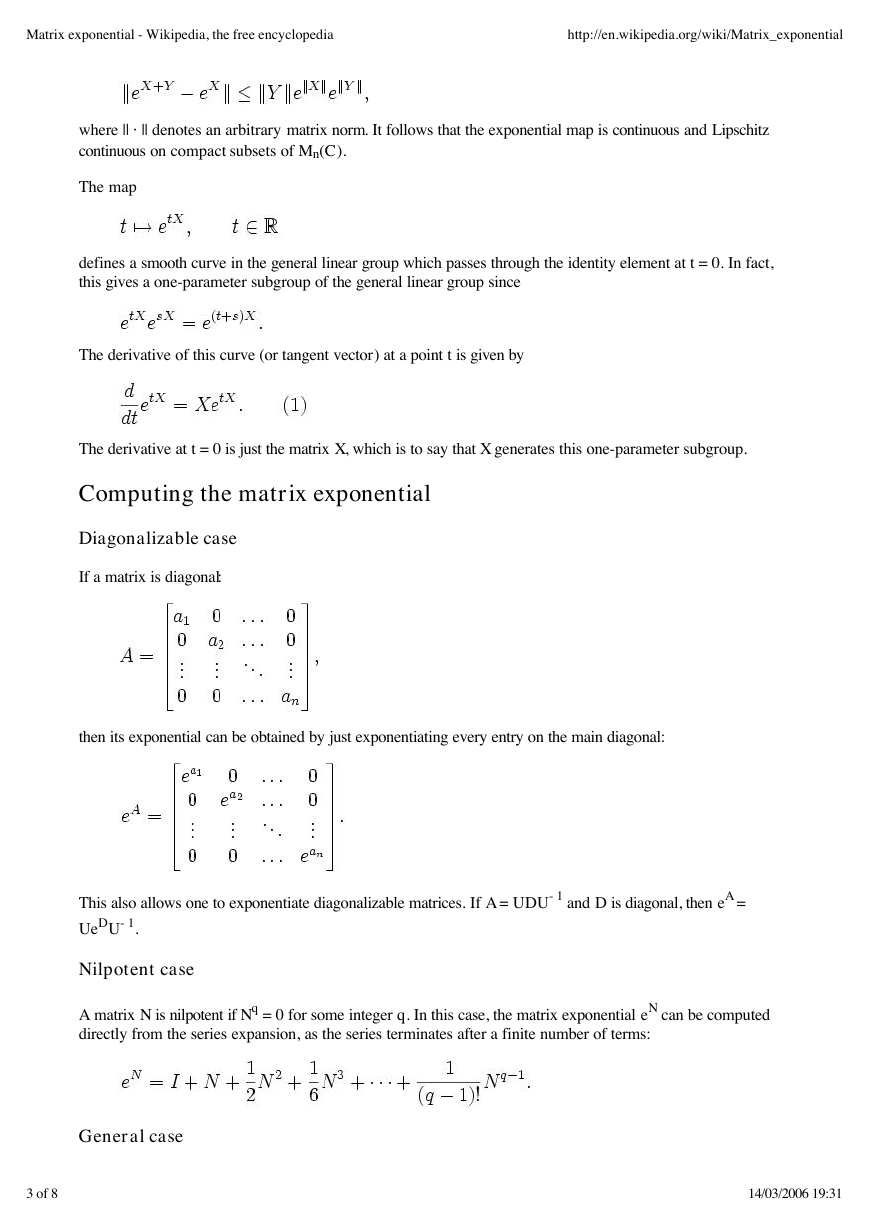
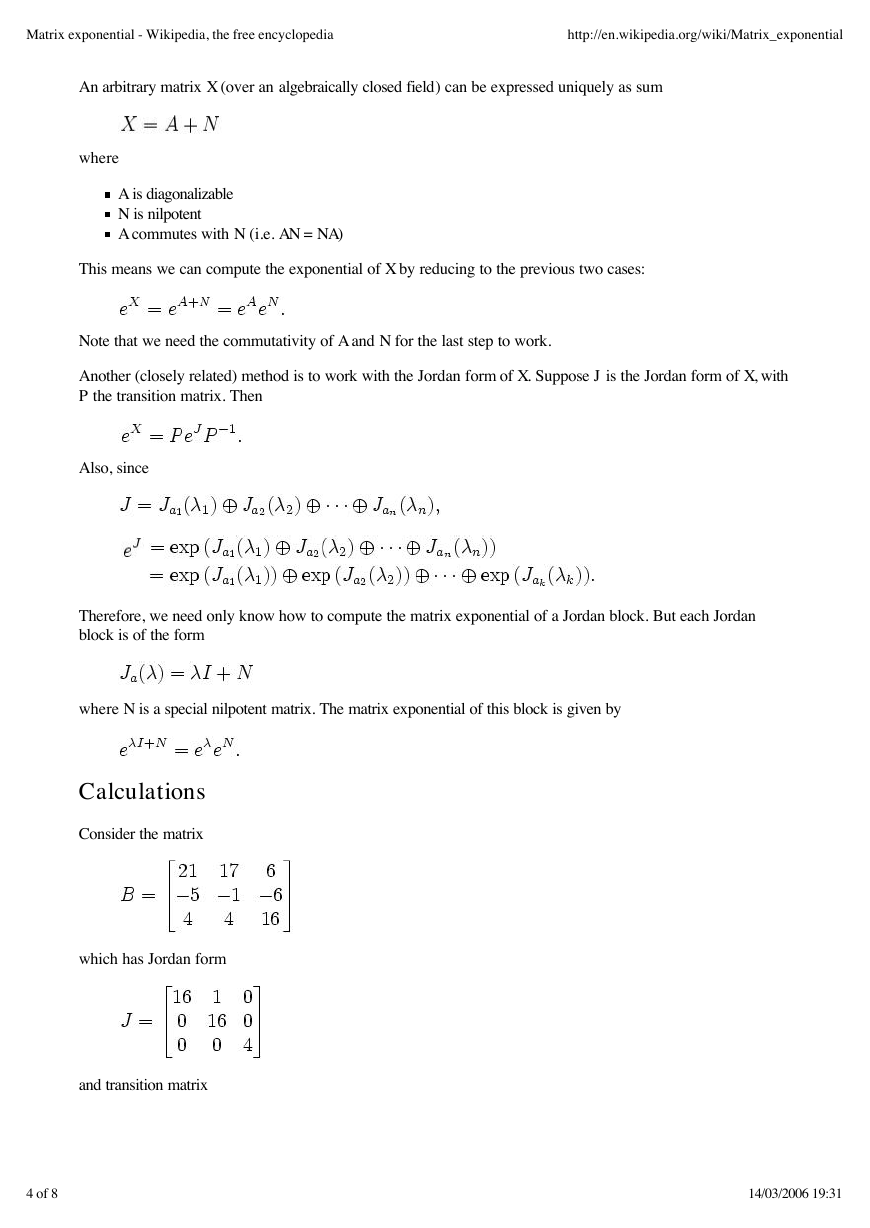

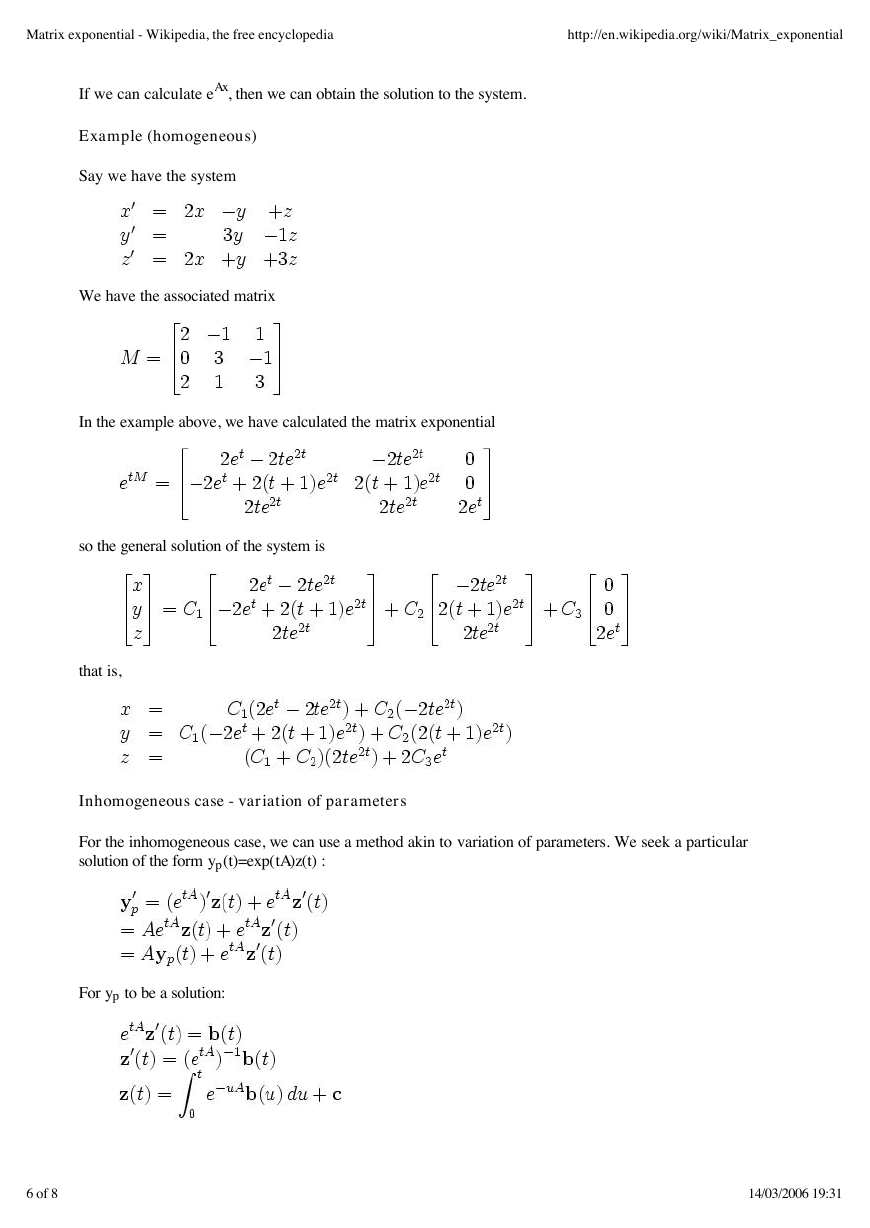










 2023年江西萍乡中考道德与法治真题及答案.doc
2023年江西萍乡中考道德与法治真题及答案.doc 2012年重庆南川中考生物真题及答案.doc
2012年重庆南川中考生物真题及答案.doc 2013年江西师范大学地理学综合及文艺理论基础考研真题.doc
2013年江西师范大学地理学综合及文艺理论基础考研真题.doc 2020年四川甘孜小升初语文真题及答案I卷.doc
2020年四川甘孜小升初语文真题及答案I卷.doc 2020年注册岩土工程师专业基础考试真题及答案.doc
2020年注册岩土工程师专业基础考试真题及答案.doc 2023-2024学年福建省厦门市九年级上学期数学月考试题及答案.doc
2023-2024学年福建省厦门市九年级上学期数学月考试题及答案.doc 2021-2022学年辽宁省沈阳市大东区九年级上学期语文期末试题及答案.doc
2021-2022学年辽宁省沈阳市大东区九年级上学期语文期末试题及答案.doc 2022-2023学年北京东城区初三第一学期物理期末试卷及答案.doc
2022-2023学年北京东城区初三第一学期物理期末试卷及答案.doc 2018上半年江西教师资格初中地理学科知识与教学能力真题及答案.doc
2018上半年江西教师资格初中地理学科知识与教学能力真题及答案.doc 2012年河北国家公务员申论考试真题及答案-省级.doc
2012年河北国家公务员申论考试真题及答案-省级.doc 2020-2021学年江苏省扬州市江都区邵樊片九年级上学期数学第一次质量检测试题及答案.doc
2020-2021学年江苏省扬州市江都区邵樊片九年级上学期数学第一次质量检测试题及答案.doc 2022下半年黑龙江教师资格证中学综合素质真题及答案.doc
2022下半年黑龙江教师资格证中学综合素质真题及答案.doc